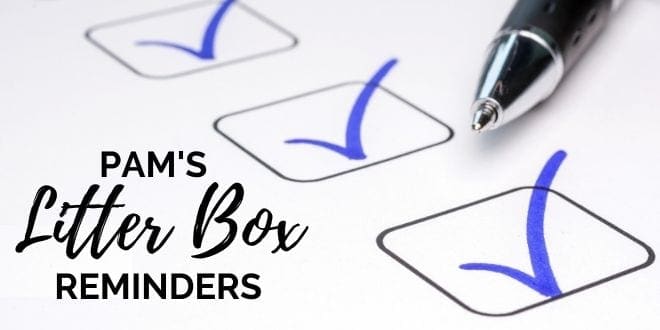
Here’s a quick checklist with some of the important things to remember when setting up and maintaining your cat’s litter box. Remember, it’s about what’s best for the cat and there are a few things on this list you may not have realized could make a difference in the success or failure of the litter box.
THE RIGHT LITTER BOX FOR YOUR CAT
- Size should be 1.5 times the length of the cat from tip of the nose to base of tail
- Boxes should be uncovered to prevent a cat from being ambushed while in there
- Use large plastic storage containers as litter boxes for bigger cats
- Kittens need low-sided boxes initially
THE RIGHT LITTER
- Cats generally prefer a soft, sandy texture
- Use unscented litter
- Maintain a 2-3″ level
- Don’t use plastic liners or litter additives
- Don’t make abrupt changes in litter brands or types
NUMBER AND LOCATION OF LITTER BOXES
- You should have the same number of boxes as cats plus an extra box for good measure
- In a multicat household, locate a box in each cat’s preferred area
- Don’t line litter boxes up in one room
- Boxes should be out in the open and not wedged in corners or closets
- Place box in an area opposite room entrance to give cat maximum visual vantage
- Multi-level homes need boxes on each floor
- Don’t place litter boxes near food or water bowls
LITTER BOX MAINTENANCE
- Scoop litter at least twice a day
- With scoopable litter, thoroughly wash box at least once a month
- With non-clumping litter, thoroughly wash box at least every 4-5 days
- Replace worn or scratched boxes as often as needed
- As you scoop, top off litter to maintain consistent levels
- Do not use plug-in air fresheners or fragrance sprays near the litter box
MONITORING OF LITTER BOX
- Twice-daily scooping allows you to monitor what is or isn’t happening in the box
- Watch for changes in appearance, odor and amount of cat’s urine clumps and fecal deposits
- Changes in litter box habits or elimination deposits need to be brought to the attention of your veterinarian
- Don’t use electronic or self-cleaning boxes because you lose the ability to monitor
- Never punish for elimination outside of the box
ADJUSTMENTS TO LITTER BOX SET-UP
- Make needed adjustments to box set-up as your cat ages or mobility decreases
- In a multicat home, make sure each cat feels safe when in the litter box
- Customize the litter box set-up to fit the needs and preferences of each cat
- Pay attention to what your cat may be communicating about the litter box set-up
DON’T TAKE SHORTCUTS WHEN IT COMES TO YOUR CAT’S LITTER BOX
- Don’t neglect litter box maintenance because a dirty box is stressful to a cat
- Don’t resort to electronic or self-cleaning boxes as a way out of daily scooping
- Don’t hide litter boxes in areas so remote that you’ll forget to maintain them
- Even if using scoopable litter, you still have to completely empty and wash the box regularly
- Cats who are allowed outdoors still need indoor litter boxes
- Don’t toilet-train your cat
NEED MORE INFORMATION?
For more specific information on dealing with litter box set-up or litter box issues, refer to the books by best-selling author, Pam Johnson-Bennett. Pam’s books are available at book stores everywhere and online. You can also purchase books through our website.
 Problem Solving & Advice by Pam Johnson-Bennett Cat Behavior Expert & Best-selling Author
Problem Solving & Advice by Pam Johnson-Bennett Cat Behavior Expert & Best-selling Author


